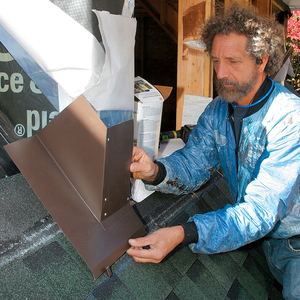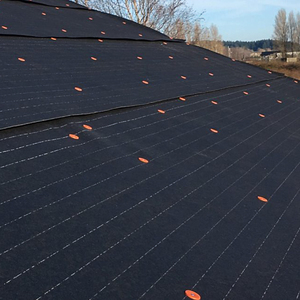
Does your asphalt shingle roof look dirty? If so, you’re not alone: after a few years, many asphalt roofs develop uneven black streaks. Some homeowners blame soot, fungus, or moss—but these designations are usually wrong. In almost all cases, the unsightly streaks are actually Gloeocapsa magma, also known as roof algae. (Moss can also occur on roofs, but moss looks like bunches of fuzzy growth, similar to the moss you see in the forest.)
Algae growth, which can also occur on wood shingles or concrete tiles, is found on roofs in all but the driest climates. (It can also appear on stucco.)
Homeowners get lots of advice about how to handle roof algae. Some people advise hiring a company to power-wash such a roof with a solution of bleach; others recommend waiting until you need to re-roof your house, when you can pay a premium for algae-resistant roof shingles.
Neither suggestion provides a long-lasting solution. The best remedy is an old-fashioned one: just install metal ridge flashing.
Algae probably don’t affect shingle life
Here’s the good news: algae do not eat asphalt. A few years ago, I spent several hours interviewing experts on the topic of roof algae. One of the experts I spoke with was Husnu Kalkanoglu, who worked at the time as director of technology at CertainTeed’s roofing division. “If you can live with the black streaks, it won’t hurt the shingles,” Kalkanoglu told me.
As far as I know, researchers haven’t studied whether algae growth shortens the life of asphalt shingles. That said, many experts volunteer opinions on the topic. When I posed the question to Kent Blanchard, the assistant vice-president of manufacturing at Tamko, a shingle manufacturer, he told me, “If anything, algae might extend the life of the shingles…
Weekly Newsletter
Get building science and energy efficiency advice, plus special offers, in your inbox.

This article is only available to GBA Prime Members
Sign up for a free trial and get instant access to this article as well as GBA’s complete library of premium articles and construction details.
Start Free TrialAlready a member? Log in















11 Comments
My roofing contractor installed a zinc strip up years ago along the ridge. It works well.
I had a thought once of buying rolls of zinc wire, to run on both sides of the ridge vent where the included nails used to set. It would be invisible, and should provide coverage from the cap downward.
I think I'll try and get a job writing roofing warranties when I retire. The preamble is easy "This document is for entertainment purposes only. Be aware that in the event of damage, you are on your own".
Very interesting. I first learned about it on TOH, where they used a metal strip applied along the ridge line.
I just saw a pictures of a potential property I'm eying. I see that the algae has dripped down from the roof and has horrendously stained big sections of the house's brick facing.
Does anyone know if that be cleaned - like it never even happened? I know algae can be killed but is there likely to be permanent staining?
Interesting problem that never got under my radar. I looked up the Wikipedia article on the subject of Gloeocapsa magma and found the following from a unmentioned source:
"The bacteria are airborne. This cyanobacteria causes substantial destruction to roofs causing shingle decay and loss of reflective power. "Over time, Gloeocapsa magma breaks down the shingles by feeding off of the limestone granules embedded in the shingles.[citation needed] This decreases a roof's ability to reflect ultra-violet rays of light and shortens the life of the roof."
Thinking back at some old roofs I've seen, I would tend to agree that this bacteria can speed up the aging of an asphalt roof.
Yes it is well understood that algae is eating limestone inside the shingles which shortens the shingle life. Lichen growth on shingles is particularly damaging as lichen will eat a hole straight through shingles! Yes to zinc strips preventing the problem.
The story of cyanobacteria is very fascinating, I have discovered. What I don't get is why it developed a sudden taste for calcium carbonate, let alone CaCO3 enrobed in asphalt. It needed nothing more than photosynthesis to thrive for eons. Has acid rain been ruled out? That'd be highly destructive to tiles containing CaCO3 of course.
I'm not a chemist but I did see something on Wikipedia re CaCO3 itself releasing CO2 under heat. I trust we are not unwittingly, slowly leaching CO2 from our asphalt shingles into the atmosphere.
But maybe the cyanobacteria is consuming the CO2 given off by the acid rain acting on the CaCO3 in the tiles. Cyanobacteria only need water, sunlight and CO2 to thrive, right?
I haven't heard a word about "acid rain" in many years, i.e. ruining cars' paint, etc. I suppose that's because the major culprits were curtailed and fined,etc. In any case, I'll assume for now that there is at least some acidity in our rain. It surely reacts with CaCO3 in roof tiles, produces CO2 and sustains the cyanobacteria.
Hey, it's all I've got.
If it's really true that the dark coating helps protect the shingles and prolong the life, the best solution is to cultivate a taste for a dark, richly textured roof color, and welcome the growth when it occurs.
For a 3 family house I own I recently chose the whitest shingle I could find from Owens Corning Duration series in order to maximally decrease summer heat gain as on the 3rd floor, and also contribute to reducing the heat island effect in the neighborhood. I was concerned it would look glary but it looks fine and, being so high up, you can barely see it from the ground anyway. From a climate change perspective, we should all be choosing the lightest color roof possible. Light roofs are common in hot climates but not in northern climates and the aesthetic runs counter to the cartoon depiction of roofs as black. I encourage everyone to choose the lightest color they can and install a zinc strip at the peak. Once we get climate change under control, in 30 years, then we can go back to installing dark shingles.
In the Pacific Northwest where we see a lot of algae and moss growth in the western parts of the states, due to living in a rainforest, having zinc strips installed on our roofs would seem very beneficial. However, the stormwater runoff can carry damaging metals that are toxic to salmon and other aquatic wildlife. So much that it's included in the Salmon Safe certification standards under standard U.1.6: https://salmonsafe.org/wp-content/uploads/2021/02/salmonsafe-urban-dev-standards-version-3.pdf
The following exterior building materials are expressly avoided: (1) zinc-based
building side panels; (2) galvanized metal and copper roofing, gutters and
downspouts; and (3) wood shingles, shakes and other outdoor wood features
treated with chromated copper arsenate or copper azole.
Ben,
The three items to be avoided do not include flashing. In fact, it's very difficult (although not impossible) to avoid the use of galvanized or copper flashing when roofing. My interpretation of the standards is that large panels of galvanized metal are to be avoided, but flashing (including ridge flashing) is not prohibited.
Log in or become a member to post a comment.
Sign up Log in